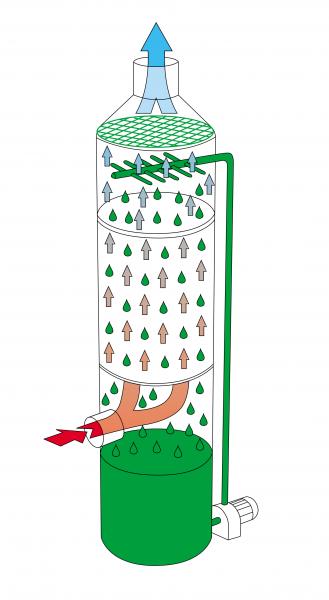Know the Packed Column Design
1. What is meant by packed column?
Packed columns are pressure vessels that contain a filling section, which are pipes or hollow tubes packed with fine particles and packing. They are usually cylindrical and made of stainless steel or glass. Generally, it is shorter than capillary columns. Columns have a higher pressure drop because they are packed with material.
Packed columns are mainly used for 3 types of separation: distillation, gas absorption, and liquid-liquid extraction. Unlike the plate column where the gas-liquid contact is staged, the gas-liquid contact in the packed column is continuous. In this design, the liquid will flow down the column and through the packaging material. As the liquid flows downward, the vapor or gas will rise upward in a countercurrent direction. Occasionally, gas absorption columns are used with the co-current flow.
Packed columns usually consist of pipes and packing and other materials, the pipes will contain most of the material as the gas and liquid will pass each other inside the container. The following is a list of the main components of a packed column:
Vessel
Spray distribution system
Reservoir
Pump
Blower
Support floor
Demister
The performance of a packed column generally depends on the correct distribution of gases and liquids in the packed bed. Therefore, the design of the packed bed column needs to take this proper distribution into account.

2. Where are packed columns used?
It is used in the petroleum industry, food, chemicals, etc. They are also commonly used in thermal power stations to assist in flue gas thermal utilization, SO2 removal, and water purification. They play a considerable role in the process industry, as the separation process of packed columns accounts for between 40% and 70% of the capital and operating costs of the industry. In addition to their separation capabilities, packed columns can also handle the direction of heat transfer between liquids and gases. This heat transfer capability makes them valuable to many companies. From a thermodynamic advantage point of view, they are top-of-the-line devices for transfer processes involving mass and heat during gas and liquid phases.
3. What are the advantages of a packed column?
are still widely used in a variety of applications due to their many advantages. From their affordability and lower pressure to their ability to fit into smaller spaces and their suitability for foaming systems, they are an excellent choice for many companies in a variety of industries.
Below you can find some of the key advantages offered by packed columns:
Wide range of selection: There are many types of carriers, fixatives, and adsorbents to choose from, which is conducive to solving the problem of separation and analysis of various components.
Cost-effective: Packed columns are often less expensive to handle corrosive liquids than comparable plate columns. This affordability makes packed columns attractive to many companies.
Ideal for Foaming Systems: Due to their structure, packed columns are best suited for handling foaming systems compared to other options.
Suitable for small diameter columns: Plates are often expensive and difficult to fit in smaller diameter columns. Packed columns are a good option if your column is less than 0.6 meters because they can be installed in areas with less space.
Lower liquid holdup: Packed columns have lower liquid holdup than plate columns. This lower position is especially useful if you are working with flammable or toxic liquids. Since you need to retain small amounts of potentially hazardous liquids to be safe, the lower liquid holdup of packed columns is ideal.
Reduced pressure drop: Typically, plate columns have higher pressure drops than packed columns. Packed columns are a good option if your column requires more stable pressure.
4. How to design a packed column?
When designing , please consider the type, column height, and column width:
Choose the size and type of packing
Packed columns can be made with random packing or structured packing.
Determine column height
The packing height is equal to the height of the transfer unit multiplied by the number of transfer units. You can determine the packing height by mass transfer analysis or equilibrium phase analysis.
Determining the column diameter
Column diameter refers to the capacity of a packed column. It is determined by identifying the cross-sectional area of the packed column. To calculate the diameter and column cross-sectional area for the required pressure drop, use the generalized pressure drop correlation.
Select and design the internal characteristics of the column
Packing support
Liquid Redistributor
Press plate



